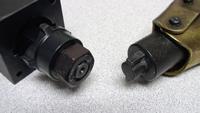- FMA
- The Fabricator
- FABTECH
- Canadian Metalworking
Categories
- Additive Manufacturing
- Aluminum Welding
- Arc Welding
- Assembly and Joining
- Automation and Robotics
- Bending and Forming
- Consumables
- Cutting and Weld Prep
- Electric Vehicles
- En Español
- Finishing
- Hydroforming
- Laser Cutting
- Laser Welding
- Machining
- Manufacturing Software
- Materials Handling
- Metals/Materials
- Oxyfuel Cutting
- Plasma Cutting
- Power Tools
- Punching and Other Holemaking
- Roll Forming
- Safety
- Sawing
- Shearing
- Shop Management
- Testing and Measuring
- Tube and Pipe Fabrication
- Tube and Pipe Production
- Waterjet Cutting
Industry Directory
Webcasts
Podcasts
FAB 40
Advertise
Subscribe
Account Login
Search
Options for Notching Pipe and Notching Tube
Six processes for notching tube, pipe
- By John Schwochert
- Updated January 24, 2023
- April 26, 2010
- Article
- Tube and Pipe Production

Figure 1: A hole saw, drum (or belt), and end mill use a rotating tool to remove the material. The hole saw and drum sander are inexpensive; the tool diameter determines the notch radius. A CNC mill, which is a more expensive option, can be programmed to make the notch’s radius.
Fabricators use notching for applications as varied as bicycle frames, automobile components, aerospace parts, and household piping systems. Notching takes many forms and shapes. The equipment and process needed depend on the notch shape, the raw material, and manufacturing considerations such as tolerance and production rate.
Tube notching is most often performed before joining tubes together to make a T or similar joint. Either one or both tubes may be notched before being welded together. End notching is the process of forming a cut on the end of a tube to create a shape that will mate to an existing tube. Side notching (offset notching) is the process of cutting an opening into the side of a tube to create a V notch for bending or a V notch for a T joint.
Six processes are used for making notches.
Hole Saws for Notching Pipe
A hole saw (see Figure 1) is simple, inexpensive, and portable, so it is suitable for job site work. In some cases a hole saw requires just a simple jig to obtain the required shape. Disadvantages include inconsistent repeatability, rough finish, limited size range, and the inability to notch shapes other than a circle.
Drum Sander, Abrasive Belt
The drum sander and abrasive-belt notcher are inexpensive notching tools. Because these use a sanding process, they generate dust, sparks, and heat. They are labor-intensive processes, limiting their suitability for high-volume production. The abrasive-belt life depends on the finish and part material. The part may need to be cleaned to remove the abrasives before welding.
End Mills for Notching Tube
End milling can be an inexpensive notching process if a CNC mill is already available. This process produces an accurate, tight-tolerance notch and the machine can be programmed to create nearly any shape imaginable. It does not produce dust or sparks. A main drawback is that the process likely will leave some chips in the tube, requiring cleaning before welding. Depending on the shape and size of the notch, cycle time can be a disadvantage.
Notching Dies for Tube and Pipe
A notching die combines low cost with good accuracy and repeatability (see Figure 2). In addition, it provides short cycle times for high-volume production runs. However, it does have some drawbacks. A die makes just one hole size and shape, so fabricators need dedicated tooling for each application. This process also tends to distort the tube.
Ram (Punch Press) Pinch Trimmer and Notcher
Like the notching die, a hydraulic press is a common choice for high-volume production runs because of its accuracy and short cycle times (see Figure 3). Another advantage is the ability to re-round or size the tube while trimming or notching. Drawbacks include the cost of the machinery and the dedicated tooling required for each application parameter—tube size and notch size and shape.
Laser Notching Tube and Pipe
Laser notching is an emerging technology that is efficient, accurate, clean, quiet, and flexible (see Figure 4). The shapes and sizes obtainable are virtually unlimited. The main drawback to this method is the cost of the machine.
About the Author
John Schwochert
Proto-1 Manufacturing LLC
10 Tower Road
Winneconne, WI 54986
920-582-4491
About the Publication
Related Companies
subscribe now

The Tube and Pipe Journal became the first magazine dedicated to serving the metal tube and pipe industry in 1990. Today, it remains the only North American publication devoted to this industry, and it has become the most trusted source of information for tube and pipe professionals.
start your free subscription- Stay connected from anywhere

Easily access valuable industry resources now with full access to the digital edition of The Fabricator.

Easily access valuable industry resources now with full access to the digital edition of The Welder.

Easily access valuable industry resources now with full access to the digital edition of The Tube and Pipe Journal.
- Podcasting
- Podcast:
- The Fabricator Podcast
- Published:
- 04/16/2024
- Running Time:
- 63:29
In this episode of The Fabricator Podcast, Caleb Chamberlain, co-founder and CEO of OSH Cut, discusses his company’s...
- Trending Articles
Team Industries names director of advanced technology and manufacturing

Orbital tube welding webinar to be held April 23

Chain hoist offers 60-ft. remote control range

Push-feeding saw station cuts nonferrous metals

Corrosion-inhibiting coating can be peeled off after use

- Industry Events
16th Annual Safety Conference
- April 30 - May 1, 2024
- Elgin,
Pipe and Tube Conference
- May 21 - 22, 2024
- Omaha, NE
World-Class Roll Forming Workshop
- June 5 - 6, 2024
- Louisville, KY
Advanced Laser Application Workshop
- June 25 - 27, 2024
- Novi, MI



























